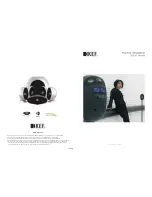
The Online / Offline indicator signals whether the selected amplifier is included in the network or
off-line. The red OFFLINE indicator signals that the corresponding amplifier is off-line and that
therefore no communication is possible.
The green ONLINE indicator shows that the corresponding amplifier is on-line and that sending and
receiving data is possible. When on-line, any parameter changes are immediately transmitted and
active.
The amplifier channels are named channel A and B. A name can be assigned to each channel to
easily identify its allocation and use. Using the left mouse button, click in the entry field and enter
the desired name for the channel. Press Return on the keyboard to acknowledge your entry.
HINT: Entering channel names is also possible within the Setup & Control Panel on the Config &
Info page.
The CLIP indicator lights whenever the signal of the internal signal processor clips. The signal
processor’s headroom is 12 dB, which is no problem when using normal filter settings. However,
when drastically increasing the level of several adjacent or overlapping filters, distortion of high-
level signals may occur, which the CLIP indicator indicates. In that case reducing the signal-level or
trying a bit more moderate equalizer setting is recommended.
The LIMIT indicator lights whenever the digital limiter of the corresponding channel is activated, e.g.
when the signal level exceeds the specified threshold and the output level is being limited to this
value.
The COMP indicator lights when the digital compressor of the corresponding channel is activated,
e.g. when the signal level exceeds the specified threshold and the output level being reduced.
The LOAD indicator shows whether the load connected to the amplifier output is within the
allowable range or if short-circuit or line interruption has occurred. The green OK-indication signals
that the connected load is between the specified lower and upper limit values. These values are set
in the Setup & Control Panel in the Load screen. The red OPEN indication signals line interruption.
It lights whenever the connected load exceeds the upper limit value. The red SHORTED indication
signals short-circuit at the amplifier output. It lights whenever the connected load falls below the
lower limit value.
HINT: The connected load is monitored continually as soon as a signal with a voltage of > 250 m V
is present at the output. Calculation of signal levels below that threshold is not possible and the
indicator shows the last acquired state.
The TEMP display shows the amplifier’s internal temperature as a graph. The indicator lights green
whenever the amplifier is operated in its normal operational temperature range. The indicator lights
yellow whenever the amplifier builds up heat because of continuous high output. However, since the
internal fans provide sufficient ventilation there is no risk of thermal overload in this state. As soon
as temperature indication changes to red, reducing the output level is strongly recommended.
Otherwise the amplifier might cease operation because of thermal overload.
When the red PROTECT indicator lights, one of the internal protections (thermal overload, short-
circuit, Back-EMF, HF at the output, etc.) has been activated. In that case, the amplifier is separated
via output relay from the connected load to prevent possible damage of the loudspeaker systems or
the amplifier itself. The cause for the fault, a short-circuited speaker line for instance, must be
remedied. In case of thermal over- load, you have to wait some time until the amplifier automatically
re-enters normal operation.
(see also Supervision & Test for additional fault information)
IRIS-Net
REMOTE AMPLIFIER | en 108
Bosch Security Systems B.V.
User Manual
2017.05 | 3.20 | F.01U.119.956
















































